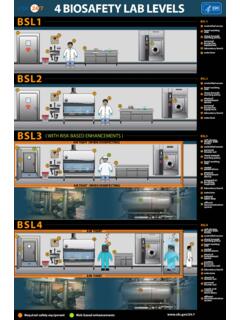Transcription of How Wastewater Treatment WorksThe Basics
1 United StatesEPA 833-F-98-002 Environmental Protection May 1998 AgencyOffice of Water (4204) BasicsOne of the most common forms of pollutioncontrol in the United States is wastewatertreatment. The country has a vast system ofcollection sewers, pumping stations, and treatmentplants. Sewers collect the Wastewater from homes,businesses, and many industries, and deliver it toplants for Treatment . Most Treatment plants werebuilt to clean Wastewater for discharge into streamsor other receiving waters, or for ago, when sewage was dumped intowaterways, a natural process of purification , the sheer volume of clean water in the streamdiluted wastes. Bacteria and other small organismsin the water consumed the sewage and otherorganic matter, turning it into new bacterial cells;carbon dioxide and other products.
2 Today s higherpopulations and greater volume of domestic andindustrial Wastewater require that communitiesgive nature a helping basic function of Wastewater Treatment is tospeed up the natural processes by which water ispurified. There are two basic stages in the treat-ment of wastes, primary and secondary, which areoutlined here. In the primary stage, solids areallowed to settle and removed from secondary stage uses biological processes tofurther purify Wastewater . Sometimes, these stagesare combined into one TreatmentAs sewage enters a plant for Treatment , it flowsthrough a screen, which removes large floatingobjects such as rags and sticks that might clogpipes or damage equipment. After sewage hasbeen screened, it passes into a grit chamber, wherecinders, sand, and small stones settle to the grit chamber is particularly important in commu-nities with combined sewer systems where sand orgravel may wash into sewers along with screening is completed and grit has beenremoved, sewage still contains organic andinorganic matter along with other suspended solids are minute particles that can beremoved from sewage in a sedimentation the speed of the flow through one of thesetanks is reduced, the suspended solids will gradu-ally sink to the bottom, where they form a mass ofsolids called raw primary biosolids formerlysludge).
3 Biosolids are usually removed from tanksby pumping, after which it may be further treatedfor use as a fertilizer, or disposed of in a land fill the years, primary Treatment alone hasbeen unable to meet many communities demandsfor higher water quality. To meet them, cities andindustries normally treat to a secondary treatmentlevel, and in some cases, also use advancedtreatment to remove nutrients and other TreatmentThe secondary stage of Treatment removes about85 percent of the organic matter in sewage bymaking use of the bacteria in it. The principalsecondary Treatment techniques used in secondarytreatment are the trickling filter and the activatedsludge effluent leaves the sedimentation tank inthe primary stage it flows or is pumped to a facilityusing one or the other of these processes. Atrickling filter is simply a bed of stones from threeto six feet deep through which sewage TREATMENTA ctivated Biosolids ProcessMore recently, interlocking pieces of corrugatedplastic or other synthetic media have also beenused in trickling beds.
4 Bacteria gather and multi-ply on these stones until they can consume most ofthe organic matter. The cleaner water trickles outthrough pipes for further Treatment . From atrickling filter, the partially treated sewage flows toanother sedimentation tank to remove trend today is towards the use of theactivated sludge process instead of trickling activated sludge process speeds up the work ofthe bacteria by bringing air and sludge heavilyladen with bacteria into close contact with the sewage leaves the settling tank in theprimary stage, it is pumped into an aeration tank,where it is mixed with air and sludge loaded withbacteria and allowed to remain for several this time, the bacteria break down theorganic matter into harmless sludge, now activated with additionalbillions of bacteria and other tiny organisms, canbe used again by returning it to the aeration tankfor mixing with air and new sewage.
5 From theaeration tank, the partially treated sewage flows toanother sedimentation tank for removal of complete secondary Treatment , effluent fromthe sedimentation tank is usually disinfected withchlorine before being discharged into receivingwaters. Chlorine is fed into the water to killpathogenic bacteria, and to reduce odor. Doneproperly, chlorination will kill more than 99percent of the harmful bacteria in an municipalities now manufacture chlorinesolution on site to avoid transporting and storinglarge amounts of chlorine, sometimes in a gaseousform. Many states now require the removal ofexcess chlorine before discharge to surface watersby a process called dechlorination. Alternatives tochlorine disinfection, such as ultraviolet light orozone, are also being used in situations wherechlorine in treated sewage effluents may beharmful to fish and other aquatic Treatment OptionsNew pollution problems have placed additionalburdens on Wastewater Treatment systems.
6 Today spollutants, such as heavy metals, chemical com-pounds, and toxic substances, are more difficult toremove from water. Rising demands on the watersupply only aggravate the problem. The increasingneed to reuse water calls for better wastewatertreatment. These challenges are being met throughbetter methods of removing pollutants at treatmentplants, or through prevention of pollution at thesource. Pretreatment of industrial waste, forexample, removes many troublesome pollutants atthe beginning, not the end, of the return more usable water to receiving lakesand streams, new methods for removing pollutantsare being developed. Advanced waste treatmenttechniques in use or under development range frombiological Treatment capable of removing nitrogenand phosphorus to physical-chemical separationtechniques such filtration, carbon adsorption,distillation, and reverse osmosis.
7 These wastewa-ter Treatment processes, alone or in combination,can achieve almost any degree of pollution controldesired, Waste effluents purified by such treat-ment, can be used for industrial, agricultural, orrecreational purposes, or even drinking watersupplies.












